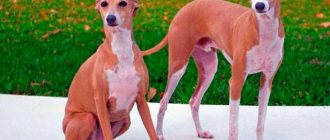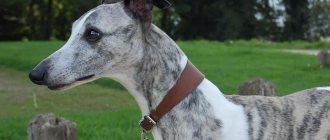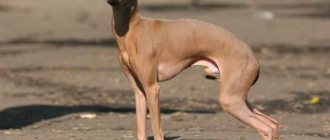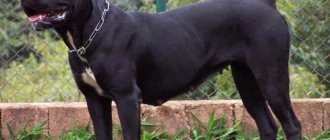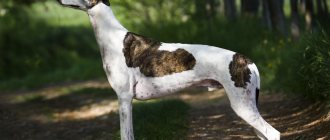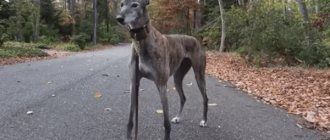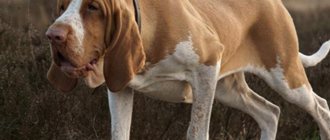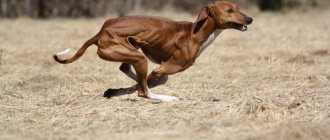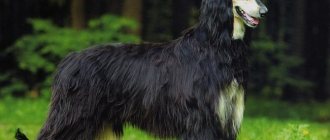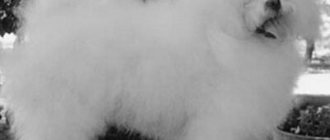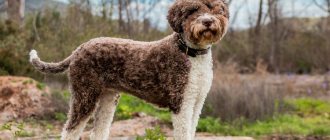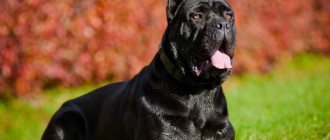Italian Greyhounds are elegant small dogs with an elongated, narrowed head and a rounded loin. Although the animals appear emaciated, they are capable of rapid speed and are rightly considered the embodiment of grace.
Gentle and affectionate dogs easily adapt to the rhythm of life of their owners, but do not tolerate neglectful treatment. Therefore, it doesn’t hurt to find out not only what Italian greyhounds are, but also what features are hidden behind the external fragility of the smallest greyhounds.
History of the origin of the breed
The Italian Greyhound is one of the oldest breeds, bred from small greyhounds in Ancient Egypt. They kept the dog in the courtyards of the pharaohs. Massive mentions date back to the period of Ancient Rome, where dogs were widespread as pets. According to images found during excavations at Pompeii, they were bathed, placed on silk pillows and scented with perfume. They gained the greatest popularity during the Renaissance. Italian Greyhounds were bred for noble families and royalty.
The appearance of the classic Italian greyhound was formed in the 20-30s of the 20th century. To stabilize the phenotype, crosses were carried out with a whippet to maintain the greyhound type, and a miniature pinscher to maintain size. This scheme made it possible to preserve the breed - it needed to get rid of impurities and inbreeding.
Photo: flickr.com
Key points in training
Thanks to their good intelligence, quick reaction and attention to detail, they are easy to train. The only problem that may arise during the training process is the dog’s high excitability and vulnerable nature. Therefore, during training, you should not allow yourself to be rude to your pet.
You can start training immediately after purchasing a puppy . Street training is best done after 3-4 months of life. For training to be successful, it is necessary to break the dog’s stubborn temperament. To do this, it is enough to become a leader for the Italian greyhound.
Read about how to properly train a dog in the article: “Training a puppy: effective methods from dog handlers, learning commands at home.”
Training is best done after an active walk, when the pet has released excess energy. To reward a dog for good academic performance, you can give it sweets, and as a punishment, raise your voice or ignore the dog.
Description of the breed
Italian Greyhounds have an elegant and refined appearance - a true mini greyhound. Its height at the withers does not exceed 38 cm. Low weight is considered the breed standard and should not exceed 4 kg. Males are larger, but sexual dimorphism is weakly expressed.
The fat Italian greyhound is an exception. The ribs protrude well on the body and there is a good volume of muscles. Thin paws and an elongated neck contribute to fast running. At a gallop they can accelerate to 40 km/h. The structure of the head is identical to large greyhounds. It is narrow and elongated, seeming disproportionately small relative to the body. This feature enhances the aerodynamic characteristics important for running. The muzzle is narrow, dark and large eyes are set symmetrically. The nose should be black, but a brown tint is acceptable. The coat is smooth and uniform.
Colors
According to the breed standard, three colors are allowed:
- gray or blue;
- black;
- red, or isabella.
A healthy dog has a coat of uniform texture. The color of an Italian greyhound is not a key factor in evaluation in the ring; it is more important for breeding. Weak pigment can lead to alopecia, the appearance of yellowness in color. When choosing an Italian greyhound, you should pay attention to the presence of white spots. They are allowed on the chest and paws. The Italian Greyhound's puppy coat is replaced at the age of 2-4 months.
Standard
Modern breed standards for Italian Greyhounds were published in 2010. Key characteristics for exhibiting a dog in the ring:
- Frame. Weighs between 2.5-4.6 kg. The length of the body is less than or equal to its height. Average height - 38 cm. The back is straight, rounding of the lower back with a transition to the croup is acceptable. The chest is narrow but powerful. There is pronounced cancer in the abdominal area.
- Limbs. Long and thin, the muscles are dry. The paws are oval in shape, the toes are tightly knit. The claws are black or brown.
- Head. Streamlined and elongated shape. There are pronounced arches of the eyebrows, slightly thickened cheekbones. The nostrils should be well opened. The muzzle is elongated and pointed. The lips fit tightly together, dark. Jaws with a scissor bite. The ears are set high, but raised at the base. Can stand upright if the dog is alert.
- Wool. Homogeneous and uniform. There should be no undercoat. Three colors of Italian Greyhound are allowed.
- Tail. Thin and long, the end has a pronounced rounding. Provides balance while moving.
The basic posture of an Italian greyhound for phenotype assessment should be slightly relaxed. At shows, muscle development is assessed, so the dog should stand in the traditional position, when an arch appears on the stomach, with the hind legs extended back.
Here is a video from a greyhound dog show.
General form
Italian Greyhounds are dogs with a very thin, slender structure and a square silhouette. They are small in size and their appearance is a miniature of the large greyhound breeds. They are "the quintessence of sophistication, elegance, grace and style."
The height at the withers of adult Italian Greyhounds is 32-38 cm in bitches and dogs, maximum body weight is 5 kg for both sexes (range 3.6-5 kg).
Character and behavioral characteristics
The Italian greyhound has an easy-going, loyal character. Capable of training and learning complex commands. In adulthood, playfulness and intelligence remain. She negatively tolerates aggression toward herself, as a result of which she becomes fearful and loses trust in people. The Italian Greyhound only shows aggression when frightened. Does not interact well with large dogs, but gets along well with small breeds.
The Italian Greyhound is good with children, but can be frightened by sudden sounds and movements. To maintain the constitution and dry muscles, the animal requires a lot of physical activity. The dwarf hound loves to run and is able to jump over fences up to 1.5 m high.
Here is a puppy playing with a cat!
Education and training
The Italian Greyhound, even as an adult, lends itself well to training and training. He quickly gets accustomed to using the toilet outside and reacts to contact in the presence of external stimuli. Demonstrates intelligence and ability when learning complex commands and various tricks. When choosing an activity, preference should be given to endurance disciplines - agility or discus. The Italian Greyhound is an excellent companion for any purpose, but is not suitable for working as a guide dog, hunter, or service dog.
Look how brave the Italian Greyhound is!
Nutrition
Premium dry food is suitable for feeding Italian greyhounds. They contain all the necessary substances.
Natural food should be fresh, prepared exclusively from healthy products. It is definitely recommended to add one teaspoon of vegetable oil to food once a day.
The basis of the diet should be lean meat, which contains cartilage and veins. The most suitable varieties are turkey, beef, and chicken breast.
Before eating, the meat should be quickly boiled or at least scalded with boiling water. But it is strictly forbidden to give the broth to the dog. Not often, but periodically it is recommended to include boiled offal in the diet.
Additionally, you need to feed your Italian greyhound:
- porridge (rice, buckwheat;
- lactic acid products, among which low-fat cottage cheese, kefir or fermented baked milk are especially useful;
- seasonal vegetables and fruits. It is recommended to give natural products very carefully, monitoring the possibility of allergic reactions in the animal.
It is strictly forbidden to add sweets, smoked meats, bread and seasonings to the prepared food. You cannot mix dry food and natural food, as this will lead to digestive upset.
Diseases
Despite their compact size, dogs of this breed live up to 15 years without health problems. The breed has strong immunity; difficulties arise from an unbalanced diet, early infection and non-compliance with the rules of care and maintenance. Typical diseases of Italian greyhounds:
- glaucoma;
- dystrophy of the retina or cornea of the eye;
- baldness (alopecia);
- epilepsy.
Italian greyhounds are often diagnosed with periodontal disease, and tartar forms early. This is due to large canines and a scissor bite. If the condition of the oral cavity is not controlled, teeth may begin to lose between the ages of 1 and 3 years. Some representatives of the breed have problems with the ears.
If your puppy's ears drop after vaccination, a mineral supplement with a high calcium content should be included in the daily diet.
Torso and tail
The body of this breed is thin and muscular (runner's muscles), and its length is equal to or only slightly less than the height at the withers. The dorsal line is straight, and in the dorsal region it is slightly curved and harmoniously merges into the line of the sacrum.
The lower line of the body does not rise very sharply towards the stomach. The low and rather long tail is all thin (even at the root) and gradually tapers to a sharp end. Greyhounds have a low and straight tail, and from the middle it curls slightly upward right to the hock joint.
Pregnancy
Puberty of the Italian greyhound begins at 8-10 months. It is advisable to carry out mating only in the second year of life, when the first 2-3 heats have passed. Mating is preferably on the territory of the bitch, where she will feel more comfortable. For mating, it is recommended to choose individuals that have similar color and dimensions.
Pregnancy lasts about 60 days; to monitor your health, it is worth keeping a detailed diary immediately after mating. Young bitches have small litters and sometimes require a caesarean section. Italian Greyhounds have a pronounced maternal instinct and do not show aggression towards puppies. Pregnant Italian hounds remain active and mobile until late pregnancy.
But the bitch feeds her puppies.
Puberty and mating
The Italian Greyhound reaches sexual maturity at 8-10 months. But it is recommended to steam a dog no earlier than 1.5 years. Only vaccinated and absolutely healthy representatives of the breed that meet the standard are allowed to mate.
Mating is carried out on the 11-15th day from the start of estrus. Before this, the dogs are given a good walk and not fed. For mating to be successful, it is organized on neutral territory or where the male lives. It is advisable to repeat the mating the next day. If fertilization has taken place, then on the 60-64th day the Italian greyhound will give birth to 2-4 puppies.
Care
The breed is intended for home keeping only. Short hair without undercoat does not allow the dog to withstand frost; in winter, it is recommended to wear insulated overalls for walking. Care instructions:
- To maintain cleanliness, the dog must be cleaned and washed; a furminator cannot be used;
- Italian Greyhounds are active dogs; walking should be constant and long. It is recommended to provide opportunities for running;
- You should brush your teeth monthly to prevent tartar buildup. For prevention, give bones and hard treats;
- The dog should have its own place in the house. For Italian Greyhounds, it is recommended to purchase a soft bed with low sides.
Training can begin at 4-5 months, when vaccinations are completed. You immediately need to wean your Italian greyhound from chewing furniture, things and relieving itself in the house.
Photo: wikimedia.org
Selection of accessories
What is required for content:
- It is recommended to purchase bowls made of metal - they are easy to clean and have an extended service life. It would be desirable to be able to adjust the height to suit your height;
- The collar for an Italian Greyhound should be wide, as the breed has a long and thin neck. The harness can only be used by adults;
- Having clothes is a mandatory requirement for walking. You need to have at least two overalls or capes for walking in the warm and cold seasons.
You should get an engraved address card with the owner’s contact information. This allows you to find an escaped animal. For walking, you can use both a leash and a tape measure.
Leather, wool and color
The skin of this breed adheres well and is relatively thin. These greyhounds have very short and silky fine hair all over their body. Their color can be uniformly gray, blue (blue fawn), black, chocolate or isabelle (fawn, that is, light yellow-beige).
White markings and spots are allowed only on the chest, forechest and lower legs (on the other hand, uniform white color is excluded).
Feeding
Italian greyhounds can be kept on natural food or dry food. The second option is preferable, since the composition contains all the necessary elements for health, a balanced proportion of BJU.
Any premium or holistic brand will do; the amount of protein and calorie content depends on the pet’s regular physical activity. The daily amount of feed depends on age, weight and brand of food. Italian Greyhound puppies should be given additional mineral supplements to maintain health.
What to feed
Despite their small size and graceful build, Italian Greyhounds have an excellent appetite. They often eat more than they need, so you need to monitor the size of portions, and most importantly, the quality of your pet’s food. What is better to feed a dog, natural food or food? First of all, nutrition should be complete and well-balanced. If you prefer dry food, choose a high-quality product from a trusted manufacturer, preferably premium and super premium. This food contains an ideal combination of all the necessary nutrients and nutritional value; there are manufacturer recommendations on serving size and number of feedings. The food is developed taking into account the breed characteristics, activity level and needs of dogs at a certain age.
Natural food should contain fresh lean meat (veal, turkey), offal, sea fish, eggs, dairy products, fruits, vegetables, and grains. It is better to coordinate such a diet with a veterinarian or breeder, who will help you choose the right combination and percentage of products.
Tips for choosing puppies
It is recommended to purchase a dog from a trusted breeder or kennel. What to look for:
- living conditions, quality of food and condition of the bitch;
- activity of puppies in the litter;
- clean skin, ears and eyes;
- RKF certificates confirming the pedigree and the absence of genetic defects of the parents.
Italian Greyhounds are ready for weaning no earlier than 2-3 months - until this age they receive all the necessary substances from their mother's milk.
Photo: wikimedia.org
How to choose a puppy
It is worth noting that buying a puppy is a very expensive and troublesome task that requires a thorough and serious approach to the matter. To make the right choice you will have to visit more than one nursery.
- First, you should visit an exhibition where you can get acquainted with the best examples of the breed, breeders and pedigrees.
- When choosing a puppy, it is important to make sure that he is completely healthy, and that his coat and ears are clean.
- You should also find out whether the dog has already been vaccinated or not.
- You need to take a closer look at the puppy's gait. It should resemble the movements of a trot. If this is so, then the puppy is healthy and does not lag behind in physical development.
In conclusion, it is worth saying that Italian Greyhounds are dogs with a sensitive and kind nature that need constant love and affection. This dog is not worth buying if it cannot be provided with the necessary care and a quiet family life. With proper care and attention, the Italian Greyhound will become a loyal and devoted friend.
3 / 5 ( 2 voices)
Owner reviews
Anna G. “An Italian greyhound has been living in our family for 5 years. This is a very smart, active and inquisitive dog. We get vaccinated and brush our teeth every year. Gets along well with the child, never shows activity. He loves to eat, he needs to limit food portions - he can eat everything he sees.”
Kirill U. “We got an Italian greyhound last year. In the first 3 months, Joy ruined all the shoes in the house and the legs of the chairs. It took us a long time to wean ourselves off this habit. Today it is a real member of the family! He tolerates the car well, loves to run outside and chase the ball. I recommend this breed for a small apartment.”
Italian Greyhounds - a historical overview of the breed
Italian Greyhounds are a breed of dog generally classified in terms of shape and utility within the greyhound group. It was created in ancient times. Dogs of similar breed and appearance to this breed were already known in the Bronze Age, as evidenced by fossil evidence and other surviving records from the period.
They were small and similar to modern greyhounds. However, the Italian Greyhound breed does not originate from Italy, that is, from the country where it is under patronage, but from North Africa, where these dogs have been bred since ancient times. People used them as hunting and pet dogs.
These four-legged animals then lived among others in Egypt at the court of the pharaohs. They also became the prototype of the Egyptian god Anubis, who had the form of such a dog. A long time ago, at the beginning of the 5th century. BC, during the migration of the then population through Laconia (ancient Greece), these small greyhounds came to Italy. This is evidenced by the numerous images of greyhound dogs from this region present on vases and bowls discovered by archaeologists.
Much later, in the eighteenth century, the breeding of dogs of this breed gained great development in Western Europe, primarily in countries such as Italy, as well as in England, France and Germany. During the Renaissance, Italian greyhounds were very fashionable and were kept as symbols of luxury in the courts of magnates. Representatives of these dogs can often be found in paintings of this era, made by the greatest Italian and other world masters.
Currently, this breed is becoming increasingly fashionable in Europe. They are now used primarily as show dogs, show and companion dogs, and hunting and racing dogs. A characteristic of Italian Greyhounds is that they hunt animals by chasing them by sight rather than by scent, like other groups of hunting breeds.
Advantages and disadvantages
Advantages of the breed:
- decorative, beautiful appearance;
- miniature sizes;
- absence of serious congenital diseases;
- learning ability, intelligence;
- simple care and maintenance;
- ability to get along with children.
Among the disadvantages are:
- predisposition to periodontal disease;
- intolerance to low temperatures;
- When exposed to strong stimuli, the dog becomes fearful.
Photo: pixabay.com
Similar breeds
All dogs related to greyhounds have similar external characteristics. There are several dogs similar to the Italian greyhound:
Greyhound (English greyhound)
It is believed that it was from this breed that the small Italian greyhound was bred. These are large dogs whose weight can reach 40 kg. The coat is smooth, possible colors are white, red, blue, brown, sand and black. One of the fastest breeds in the world.
Photo: wikipedia.org
Whippet
This dog is distinguished by its larger size, wide range of colors and overall appearance. Has pronounced watchdog qualities and temperament. Occupies an intermediate position between the Italian Greyhound and the Greyhound. Used for hunting.
Photo: wikimedia.org
Italian Greyhounds, unlike other breeds in the class, are not used for working tasks today. They have lost their guard and hunting skills. In addition, they were originally bred as an ornamental pet.
Interesting Facts
Over the centuries-old history of the existence of Italian Greyhounds, a lot of interesting things have happened to them:
- There are several versions of the origin of the name of the breed. According to one of them, it comes from the French word lievre, which means “hare”. According to another, more romantic version, the name of the breed has German roots and is translated as “toy of the wind.” The same name was given to the holiday held in Peterhof and dedicated to Catherine II's Italian greyhound named Zemira. After the death of her beloved dog, the empress ordered the construction of a tomb for her, similar to an Egyptian pyramid.
- In different eras, the owners of Italian greyhounds were such celebrities as Cleopatra, Julius Caesar, Francis I, Louis XV and Queen Victoria. And Alphonse de Lamartine dedicated poems to Italian greyhounds and called them “birds on all fours.”
- Italian Greyhound has several alternative names. In various sources, dogs of this breed are referred to as the Italian Greyhound and the Italian Greyhound.
Photo
Photo: wikimedia.org
Photo: wikimedia.org
Photo: pixabay.com
Photo: wikimedia.org
Briefly about the main thing
- Italian Greyhound is an elegant breed from the hound class. Ideal for keeping in an apartment due to its small size. Gets along with children.
- The pet is easy to care for; the fur does not need to be combed from the undercoat.
- Good learning ability, ability to master complex commands.
- The dog's activity and energy make it possible to use it as a running companion.
Tell us in the comments about your experience of keeping an Italian greyhound. What difficulties have you encountered in the process of raising a pet?
Did you like the article? Share it with your friends on social media. networks. This will help them get useful information and support our project.
Italian greyhound price
The cost of an Italian Greyhound puppy varies widely. It depends on the origin of the dog and its future prospects:
- The cheapest puppy is one without documents or with obvious defects. Its price is 5-10 thousand rubles.
- A puppy with a good pedigree costs on average 30-40 thousand rubles.
- For a descendant of international champions with the prospect of an exhibition career, you will have to pay 50-80 thousand rubles.
The Italian Greyhound is a graceful miniature greyhound with a rich history and a timid, sensitive nature. She will be an excellent companion for non-conflict people who can surround her with care and attention.
